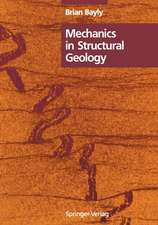The Practice of Reservoir Engineering (Revised Edition)
Autor L.P. Dakeen Limba Engleză Paperback – 9 mai 2001
Preț: 521.26 lei
Preț vechi: 835.71 lei
-38% Nou
Puncte Express: 782
Preț estimativ în valută:
99.75€ • 106.66$ • 83.16£
99.75€ • 106.66$ • 83.16£
Carte tipărită la comandă
Livrare economică 10-24 aprilie
Preluare comenzi: 021 569.72.76
Specificații
ISBN-13: 9780444506719
ISBN-10: 0444506713
Pagini: 572
Dimensiuni: 156 x 234 x 22 mm
Greutate: 1.04 kg
Ediția:Rev
Editura: ELSEVIER SCIENCE
ISBN-10: 0444506713
Pagini: 572
Dimensiuni: 156 x 234 x 22 mm
Greutate: 1.04 kg
Ediția:Rev
Editura: ELSEVIER SCIENCE
Cuprins
Preface.About the Author.Nomenclature.Chapter 1 Introduction to Reservoir Engineering. Activities in reservoir engineering. Basic themes of the text. The role of reservoir engineers. Technical responsibilities of reservoir engineers. The physical principles of reservoir engineering. References. Chapter 2 The Appraisal of Oil and Gas Fields. Introduction. Pressure-volume-temperature fluid properties for oil. Calculation of the stock tank oil initially in place. Field unitization/equity determination. Calculation of gas initially in place(GIIP). Pressure-depth plotting. Application of the repeat formation tester. Pulse testing using the repeat formation tester. Appraisal well testing. Extended well testing. References. Chapter 3 Material Balance Applied to Oilfields. Introduction. Derivation of the cumulative material balance for oil reservoirs. Necessary conditions for application of material balance. Solving the material balance (knowns and unknowns). Comparison between material balance and numerical simulation modelling. The opening move in applying material balance. Volumetric depletion fields. Water influx calculations. Gascap drive. Compaction drive. Conclusion. References. Chapter 4 Oilwell Testing. Introduction. Essential observations in well testing. Well testing literature. The purpose of well testing. Basic, radial flow equation. Constant terminal rate solution of the radial diffusivity equation. The transient constant terminal rate solution of the radial diffusivity equation. Difficulties in application of the constant terminal rate solution of the radial diffusivity equation. Superposition of CTR solutions. Single-rate drawdown test. Pressure buildup testing (general description). Miller, Dyes, Hutchinson (MDH) pressure buildup analysis. Horner pressure buildup analysis. Some practical aspects of appraisal well testing. Practical difficulties associated with Horner analysis. The influence of fault geometries on pressure buildups in appraisal well testing. Application of the exponential integral. Pressure support during appraisal well testing. Well testing in developed fields. Multi-rate flow testing. Log-log type curves. Conclusions. References. Chapter 5 Waterdrive. Introduction. Planning a waterflood. Engineering design of waterdrive projects. The basic theory of waterdrive in one dimension. The description of waterdrive in heterogeneous reservoir sections. Waterdrive under segregated flow conditions (vertical equilibrium). Waterdrive in sections across which there is a total lack of pressure equilibrium. The numerical simulation of waterdrive. The examination of waterdrive performance. Difficult waterdrive fields. References. Chapter 6 Gas Reservoir Engineering. Introduction. PVT requirements for gas-condensate systems. Gas field volumetric material balance. The dynamics of the immiscible gas-oil displacement. Dry gas recycling in retrograde gas-condensate reservoirs. References. Subject Index.
Recenzii
"This book is particularly suitable for the hard pressed reservoir/production engineers in its advice, illustrated with 27 examples and exercises based mainly on actual field developments." --Inis/Energy"intended for those in the oil industry requiring a working knowledge of how the subject of hydrocarbon reservoir engineering can be applied in the field." --Geo AbstractsMalcolm Pye"This book tells you all you need to know about reservoir engineering. ...written with (a) wit and style. .. It's a practical book with special emphasis on the offshore, concerned with processes on the scale of "hillsides" not coreplugs. It begins with an introduction inspired by the absence of the word "reservoir" in Daniel Yergin's history of the oil industry, "The Prize". Armed only with Occam's Razor, Laurie tackles the observations, assumptions and calculations that underpin the subject while offering career advice en route - the best time to move jobs is when appraisal has finished and before development begins! ...Chapter 5 is Laurie's masterpiece, 150 pages on waterdrive which could be published as a book in its own right. Drawing on examples from the North Sea, "the biggest laboratory ever for the study of waterdrive" it demolishes the misconceptions that have grown up over relative permeability curves and stresses the importance of the fractional flow equation in understanding fluid displacement. The section on the effects of vertical permeability distributions on waterflooding should be required reading for every oil company geologist." --PES GB










